Hello! If you have found your way to this little corner of the internet, I take it that you are at least somewhat interested in learning how to spin yarn. Well, new friend, you have come to the right place! I started spinning over a decade ago, and I am here to tell you all of the things I wish I had known when I first got “the spinning itch.”
Just as you have found your way here, I am sure you have likely Googled or searched on YouTube for various resources about spinning. We are fortunate to live in a time when resources are rich, with plenty of tutorials and guides to help new spinners out.
When I first started spinning, there weren’t too many out there. I remember finding a video that Knit Picks had produced and watching it relentlessly. And I mean I watched it All. The. Time. I was mesmerized not only by the techniques displayed but the tools and fibers shown. It all seemed otherworldly and magical to me. I wanted to know everything I could – and I didn’t even have a spindle or a wheel yet. I just knew I wanted to be a part of it. So that’s exactly what I did.
Your space
When thinking about your new spinning journey, there are a few things I would recommend you consider. First, consider your space. Do you live in a cramped apartment? A big house? Maybe you have only a studio space or bedroom.
No matter how big or small your space is, your spinning will most likely take place here, too, and it’s important to be realistic. A spindle, for example, can easily sit on a bookshelf or be tucked into a bag. A giant saxony wheel will require a lot of space but also a certain amount of protection from animals and children.
When thinking about the difference between a spindle and a wheel, think about the lifestyle in your home space – is it busy? Would it be easy for your wheel to get bumped and bruised? Or perhaps you only want to spin at the office or on the commute while running errands? A spindle is perfect for mobility or a cramped space.
Your budget
The next thing to think about is finances. Do you have a budget in mind? When I talk to people who know little about making yarn, they are stunned to find out how much fiber can cost and the wide range of money that can be required for certain equipment. While this is definitely a spectrum (heck, some lucky spinners can find good wheels at garage sales!), thinking about the money and quality of your tools is critical.
You do not have to drop a ton of money to be a creative and happy spinner, but I like to think of our tools as something that we will have for a long time. If you have a tattoo or an original piece of art, it’s much the same. You are paying for something you will have for the long haul and should try to invest in that quality if possible.
Your tools
Now that you have thought about space and money (not super fun, IMHO), we can get into the more fun stuff. Tools! I’ve tried a few different brands of wheels and spindles and have taught new spinners on both.
As far as wheels are concerned, the Ashford Kiwi is a popular wheel for new spinners. The Kiwi is a double treadle, has decent ratios (speed) to adjust, has a flexible drive band, and is easy for bobbin changes with sliding flyer hooks.
Some of this might sound foreign to you if you have not yet started spinning, but that is okay. There is a lot of language to understand and learn – and you will learn it all in no time, trust me!
As far as spindles go, I like the Schacht drop spindle with a top whorl. It is well balanced and a good tool for the beginner. I have several other spindles that I enjoy, and I personally prefer a heavier drop spindle (bonus points if they are cute like the magical Christmas whorl I have!).
Depending on the kind of yarn you want to spin, different wheels and different spindles will lend themselves better to you. If you simply want to spin and have yet to think about the kind of yarn you want to spin, don’t worry too much about this. But if you are, say, a sock knitter and want to spin your own sock yarn, you are going to want to find tools that can spin fast to build up high twist in your fiber. Again, this is something to sort of tuck away for a rainy day after you have learned the basics.
You’ll also want to get something called a niddy-noddy. I know – it’s a wonderful word, isn’t it? This tool is what will help you figure out how much yarn you have spun and will also help you put your yarn into a hank and skein. Niddy-noddies come in different sizes and will also become a sort of personal preference.
Other than a niddy-noddy, you may want something called a kate. This is basically a tool used to hold your bobbins when you are not spinning on them or if you are plying from bobbins. Some wheels have a built-in kate. You can also make your own kate by using an old shoe box, punching holes on both sides, and placing a wooden dowel in the middle.
Your fiber
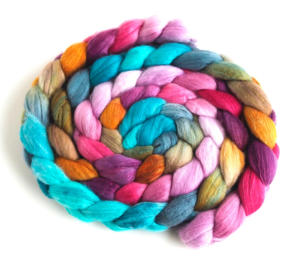
A beautiful example of hand-dyed top, a versatile fiber preparation. Photo credit: Three Waters Farm
Now, the really fun part: fiber. Just like going to your favorite yarn store and selecting yarn, you will quickly find that selecting fiber is just as much fun. I love seeing different colors and blends. It is just so exciting!
There are a lot of options out there, and some breeds and fibers lend themselves better to beginners than others. I highly recommend Bluefaced Leicester (BFL), Corriedale, Rambouillet, and Falkland for new spinners. These breeds are readily available by many commercial and indie dyers, and have a spinability that I love and highly recommend. They are not too slippery, and they are not too rough. They are pleasant to the touch and are easy to draft.
When selecting fiber to spin, look for colors that inspire you or give you joy. Don’t fret too much about ruining the fiber. This may happen and you’ll goof up as you learn – prepare for that and know that it is okay! But while you are making mistakes (aka learning) at least you will be enjoying the fiber you have selected.
I hope this has helped you out a little bit, and you are better prepared for the journey ahead! Spinning is a delight and there’s much to learn, but when scaled back, it is a bit more manageable as a beginner. My greatest advice is to just jump right in! Take a class, borrow a wheel from a friend, or go ahead and buy that spindle! Follow your joy and the rest will fall in place.
Happy spinning!
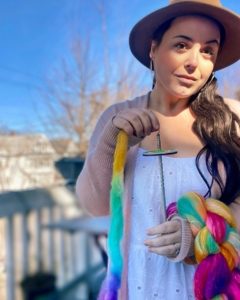 Tracy Murphy is a fiber enthusiast located in Buffalo, NY. She is a spinner, knitter, and yarn dyer and most recently has added knitwear designer to her list of wooly vocations. She enjoys teaching new spinners and knitters alike and believes everybody should be included in the wonderful word of fiber arts.
Tracy Murphy is a fiber enthusiast located in Buffalo, NY. She is a spinner, knitter, and yarn dyer and most recently has added knitwear designer to her list of wooly vocations. She enjoys teaching new spinners and knitters alike and believes everybody should be included in the wonderful word of fiber arts.
Special thanks to Three Waters Farm for providing a picture for this article.


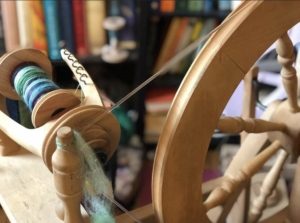
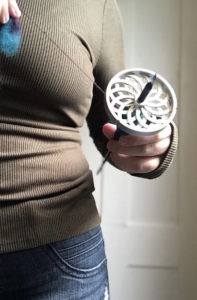
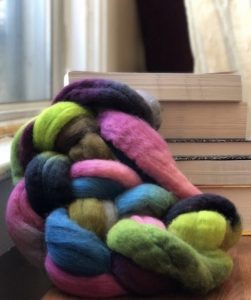
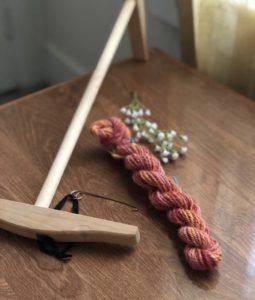

 Shilo Weir
Shilo Weir
Leave a Reply
Want to join the discussion?Feel free to contribute!